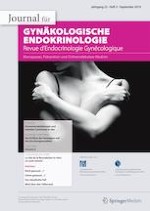28.08.2019 | Orthomolekulare Medizin
Vitamin K
Erschienen in: Journal für Gynäkologische Endokrinologie/Schweiz | Ausgabe 3/2019
Einloggen, um Zugang zu erhaltenZusammenfassung
Der Begriff Vitamin K umfasst verschiedene verwandte Substanzen, welche als Grundstruktur einen Naphthochinonring aufweisen. Strukturell unterscheiden sich die verschiedenen Substanzen der Vitamin-K-Gruppe durch die Länge und Sättigung der Seitenketten. Für den Menschen sind aufgrund der Funktionen vor allem das Vitamin K1 und das Vitamin K2 von Bedeutung. Bis anhin wurde der Begriff Vitamin K hauptsächlich mit der Funktion von Vitamin K1 in der Blutgerinnung verbunden. Bei einem Versagen dieser Funktion stellt sich eine akute und lebensbedrohliche Situation ein, weshalb Vitamin K bevorzugt in die Leber transportiert wird für die Synthese der Blutgerinnungsfaktoren. Neuere Forschungen zeigen, dass die Funktionen der K-Vitamine jedoch weit darüber hinaus reichen. Es sind positive Effekte auf die Gefässgesundheit, den Knochenstoffwechsel, die Zellteilung und -migration, den mitochondrialen Energiestoffwechsel, den Glukose- und Insulinstoffwechsel und die Kognition nachweisbar. Diese Effekte werden hauptsächlich dem Vitamin K2 zugeschrieben. Ein Mangel zeigt sich in diesen extrahepatischen Geweben erst nach vielen Jahren in Form von z. B. Osteoporose, Arteriosklerose oder Krebs. Es wird angenommen, dass ein grosser Teil der Bevölkerung von einem solchen subklinischen, sekundären Vitamin-K-Mangel betroffen ist. Bei der Substitution ist das Vitamin K in Form von Menachinon‑7 zu bevorzugen. Dieses hat die beste Bioverfügbarkeit und wirkt somit am effektivsten.
Anzeige
